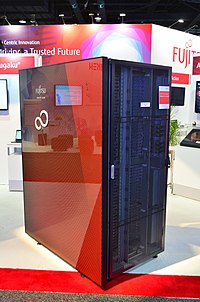Fugaku (supercomputer)
Fugaku or Fuji is the name of a supercomputer newly installed in May 2020 at the RIKEN Center for Computational Science in Kobe, Japan . This computer is the successor to the K computer supercomputer and like it was developed and manufactured by the Fujitsu company , which is why it was also called Post K computer during its development . With this development, the Fujitsu company broke new ground in many ways: First, the heart of the computer, the CPU's, was developed with a different instruction set , an ARMv8 -64 bit instruction set, which was expanded by a new SIMD unit, called Scalable Vector Extensions - SVE , the A64FX processor. The conception of the computer with system-on-a-chip nodes means that the computing efficiency is very high, in the area of specialized computing accelerators. The SIMD or vector unit can process several data formats (Double Precision FP 64 bit, Single Precision FP 32 bit, Half Precision FP 16 bit, INT8) in parallel and is therefore also very suitable for AI applications. Fujitsu has developed its own compilers that can use the vector unit without special code, so the software developers do not need any special libraries or frameworks such as CUDA to obtain the SIMD advantages. The integrated water cooling allows the waste heat to be used and thus further increases the system efficiency.
A64FX
The A64FX processor is manufactured by TSMC in a 7 nm process and is constructed as a cluster on a chip consisting of 4 clusters of 12 ARM cores each and an HBM 2 stack of 8 GB each. The four clusters are connected by a ring bus, on the chip there is also the input / output unit, 16 PCIe Gen3 channels and the network switch, consisting of a total of 10 TOFU 3 channels with 28 Gbps each. This means that the processor can be called a system-on-a-chip (SOC), as all the components required for a complete computer ("node") are integrated. The exclusive use of HBM stacks as main memory ensures a very high memory bandwidth. The chip has a total of 48 ARM cores with 32 GB of RAM.
Structure of the system
The centerpiece is the interconnection of the supercomputer as a fault-tolerant TOFU network: 8 nodes are interconnected with 4 channels each as a hypercube, 6 additional channels are used for global and fault-tolerant interconnection. Fujitsu calls this a 6-dimensional torus network.
- Fujitsu integrates 2 CPU's with network, power and water cooling connections on a Compute Memory Unit (CMU), a blade server with 2 nodes, so to speak.
- 8 shelves with 24 CMU slots each are installed in a rack
- together there are 192 CMUs or 384 CPUs / nodes or 18432 cores in one rack
- the installation of more than 400 racks was completed on May 13, 2020.
The computer currently has 158976 nodes with more than 7 million CPU cores.
Fugaku is expected to top the next edition (in June 2020) of the TOP500 and the Green500 supercomputer lists with values of 537 Peta-FLOPS (Linpack). The Fugaku prototype system already topped the Green500 list from November 2019 with 16.9 GigaFLOPS / watt.
Individual evidence
- ↑ With Fugaku Supercomputer Installed, RIKEN Takes On Coronavirus. In: The Next Platform. May 18, 2020, accessed on May 18, 2020 .
- ↑ Delivery of the Fugaku supercomputer has been Completed. In: RIKEN Center for Computational Science. May 13, 2020, accessed on May 18, 2020 .
- ↑ Satoshi Matsuoka. In: Twitter.com. May 15, 2020, accessed on May 15, 2020 .
- ↑ A64FX prototype - Fujitsu A64FX. In: www.top500.org. Retrieved May 18, 2020 .
